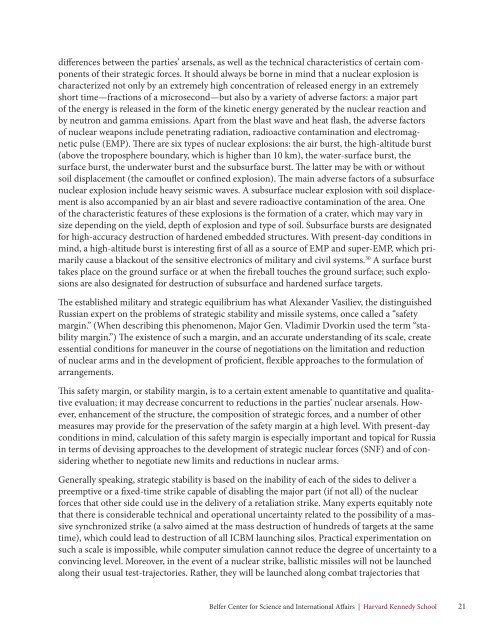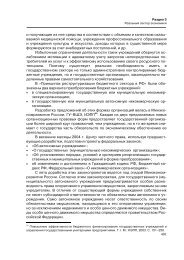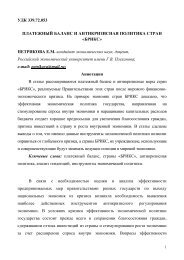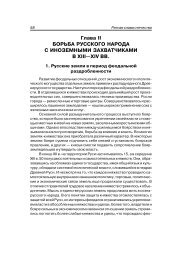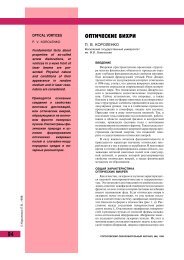Ensuring Strategic Stability in the Past and Present:
Ensuring Strategic Stability in the Past and Present:
Ensuring Strategic Stability in the Past and Present:
Create successful ePaper yourself
Turn your PDF publications into a flip-book with our unique Google optimized e-Paper software.
differences between <strong>the</strong> parties’ arsenals, as well as <strong>the</strong> technical characteristics of certa<strong>in</strong> componentsof <strong>the</strong>ir strategic forces. It should always be borne <strong>in</strong> m<strong>in</strong>d that a nuclear explosion ischaracterized not only by an extremely high concentration of released energy <strong>in</strong> an extremelyshort time—fractions of a microsecond—but also by a variety of adverse factors: a major partof <strong>the</strong> energy is released <strong>in</strong> <strong>the</strong> form of <strong>the</strong> k<strong>in</strong>etic energy generated by <strong>the</strong> nuclear reaction <strong>and</strong>by neutron <strong>and</strong> gamma emissions. Apart from <strong>the</strong> blast wave <strong>and</strong> heat flash, <strong>the</strong> adverse factorsof nuclear weapons <strong>in</strong>clude penetrat<strong>in</strong>g radiation, radioactive contam<strong>in</strong>ation <strong>and</strong> electromagneticpulse (EMP). There are six types of nuclear explosions: <strong>the</strong> air burst, <strong>the</strong> high-altitude burst(above <strong>the</strong> troposphere boundary, which is higher than 10 km), <strong>the</strong> water-surface burst, <strong>the</strong>surface burst, <strong>the</strong> underwater burst <strong>and</strong> <strong>the</strong> subsurface burst. The latter may be with or withoutsoil displacement (<strong>the</strong> camouflet or conf<strong>in</strong>ed explosion). The ma<strong>in</strong> adverse factors of a subsurfacenuclear explosion <strong>in</strong>clude heavy seismic waves. A subsurface nuclear explosion with soil displacementis also accompanied by an air blast <strong>and</strong> severe radioactive contam<strong>in</strong>ation of <strong>the</strong> area. Oneof <strong>the</strong> characteristic features of <strong>the</strong>se explosions is <strong>the</strong> formation of a crater, which may vary <strong>in</strong>size depend<strong>in</strong>g on <strong>the</strong> yield, depth of explosion <strong>and</strong> type of soil. Subsurface bursts are designatedfor high-accuracy destruction of hardened embedded structures. With present-day conditions <strong>in</strong>m<strong>in</strong>d, a high-altitude burst is <strong>in</strong>terest<strong>in</strong>g first of all as a source of EMP <strong>and</strong> super-EMP, which primarilycause a blackout of <strong>the</strong> sensitive electronics of military <strong>and</strong> civil systems. 30 A surface bursttakes place on <strong>the</strong> ground surface or at when <strong>the</strong> fireball touches <strong>the</strong> ground surface; such explosionsare also designated for destruction of subsurface <strong>and</strong> hardened surface targets.The established military <strong>and</strong> strategic equilibrium has what Alex<strong>and</strong>er Vasiliev, <strong>the</strong> dist<strong>in</strong>guishedRussian expert on <strong>the</strong> problems of strategic stability <strong>and</strong> missile systems, once called a “safetymarg<strong>in</strong>.” (When describ<strong>in</strong>g this phenomenon, Major Gen. Vladimir Dvork<strong>in</strong> used <strong>the</strong> term “stabilitymarg<strong>in</strong>.”) The existence of such a marg<strong>in</strong>, <strong>and</strong> an accurate underst<strong>and</strong><strong>in</strong>g of its scale, createessential conditions for maneuver <strong>in</strong> <strong>the</strong> course of negotiations on <strong>the</strong> limitation <strong>and</strong> reductionof nuclear arms <strong>and</strong> <strong>in</strong> <strong>the</strong> development of proficient, flexible approaches to <strong>the</strong> formulation ofarrangements.This safety marg<strong>in</strong>, or stability marg<strong>in</strong>, is to a certa<strong>in</strong> extent amenable to quantitative <strong>and</strong> qualitativeevaluation; it may decrease concurrent to reductions <strong>in</strong> <strong>the</strong> parties’ nuclear arsenals. However,enhancement of <strong>the</strong> structure, <strong>the</strong> composition of strategic forces, <strong>and</strong> a number of o<strong>the</strong>rmeasures may provide for <strong>the</strong> preservation of <strong>the</strong> safety marg<strong>in</strong> at a high level. With present-dayconditions <strong>in</strong> m<strong>in</strong>d, calculation of this safety marg<strong>in</strong> is especially important <strong>and</strong> topical for Russia<strong>in</strong> terms of devis<strong>in</strong>g approaches to <strong>the</strong> development of strategic nuclear forces (SNF) <strong>and</strong> of consider<strong>in</strong>gwhe<strong>the</strong>r to negotiate new limits <strong>and</strong> reductions <strong>in</strong> nuclear arms.Generally speak<strong>in</strong>g, strategic stability is based on <strong>the</strong> <strong>in</strong>ability of each of <strong>the</strong> sides to deliver apreemptive or a fixed-time strike capable of disabl<strong>in</strong>g <strong>the</strong> major part (if not all) of <strong>the</strong> nuclearforces that o<strong>the</strong>r side could use <strong>in</strong> <strong>the</strong> delivery of a retaliation strike. Many experts equitably notethat <strong>the</strong>re is considerable technical <strong>and</strong> operational uncerta<strong>in</strong>ty related to <strong>the</strong> possibility of a massivesynchronized strike (a salvo aimed at <strong>the</strong> mass destruction of hundreds of targets at <strong>the</strong> sametime), which could lead to destruction of all ICBM launch<strong>in</strong>g silos. Practical experimentation onsuch a scale is impossible, while computer simulation cannot reduce <strong>the</strong> degree of uncerta<strong>in</strong>ty to aconv<strong>in</strong>c<strong>in</strong>g level. Moreover, <strong>in</strong> <strong>the</strong> event of a nuclear strike, ballistic missiles will not be launchedalong <strong>the</strong>ir usual test-trajectories. Ra<strong>the</strong>r, <strong>the</strong>y will be launched along combat trajectories thatBelfer Center for Science <strong>and</strong> International Affairs | Harvard Kennedy School 21


